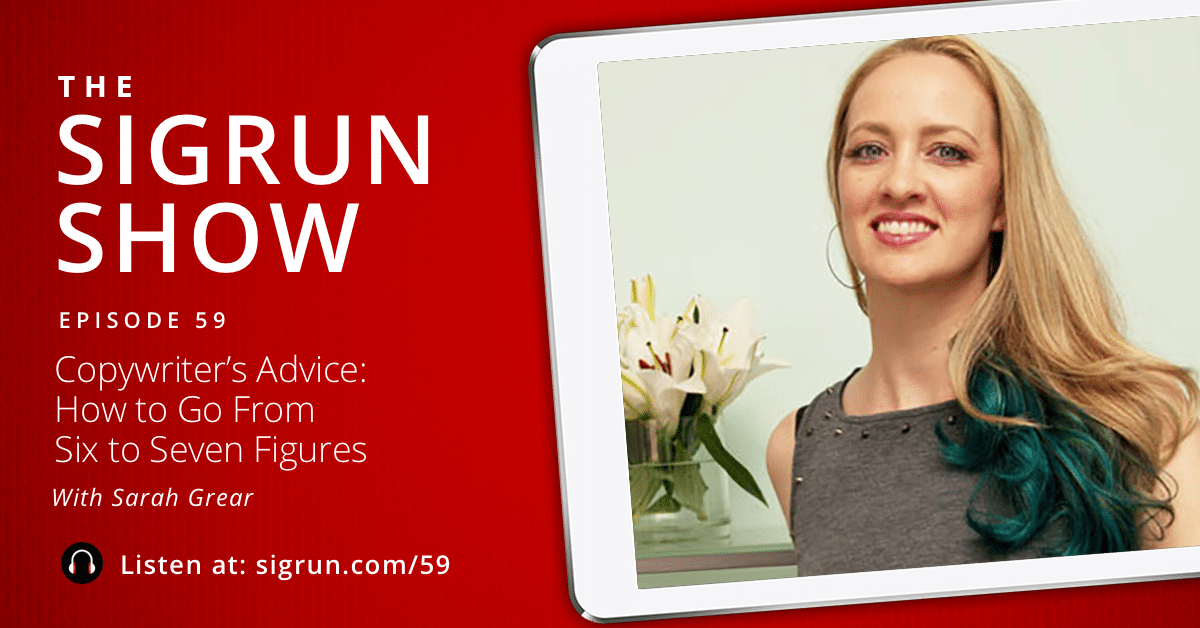
Copywriter's Advice: How to Go From Six to Seven Figures
Words hold a lot of power, especially for online businesses. With your copywriting, you convince your target audience that your product or service will solve their need and offer them value.
Sarah Grear, copywriter and copy conversion expert, works with six and seven figure coaches and helps them improve their copywriting. Here, she shares when it’s time to hire a copywriter and how these coaches are able to grow their business beyond the six and even up to seven figures by using the right content strategy.
Be Willing to Experiment
People usually find Sarah when they’re having their first six figure launch. “That’s when they start needing support with their launch copy. However, I also had clients who are already making 1.2 million or more a year and they hadn’t hired a copywriter yet.”
Sarah says that you can reach certain benchmarks without hiring a copywriter. “There’s a couple of questions you have to ask yourself though. One, content creation can be overwhelming when you get to a certain point in your business. How painful do you want it to be? And two, can you be a copywriter? Can you just do it yourself? You have to be willing to experiment. Try being a copywriter for yourself. If your offer falls flat and you crash and burn, or if the work overwhelms you, then it's time to get on the phone with a copywriter and pass on the task.”
At a certain point in your business, you might even want to move from hiring subcontractors to building an in house team, including at least one dedicated copywriter. “I see this happen when entrepreneurs get to the seven figure mark. Their needs are more immediate, and can get satisfied more efficiently with a team. The team often consists of a personal assistant, a copy production person and someone doing the videos.”
Hiring a Copywriter
If you decide to hire a copywriter, there are a few things you should consider. “Some copywriters focus on writing copy for websites and building brand authority through your home and services page. Others focus on doing what I do, which is copy conversions. They start looking at the data and create the copy based on things that have worked in the past. They look at surveys and actually analyze what the audience is saying and use that language. Keep in mind that not every copywriter is trained in that.” Sarah says if you can pair the science that is looking at the data with the art that is being able to creatively tell a story, it really makes the difference in terms of copy conversion.
Before you hire a copywriter, ask to see examples of other launches they did or websites they created copy for. “When you look at their copy, don’t focus too much on the style they used for one particular client, because ideally it will be different from one client to the next. If they all sound the same, the copywriter's just using their own voice, not actually gathering the data and using your voice and the voice of the audience.”
Working with one copywriter long term can benefit your business. “The person will get to know your voice, and it’s easier to continue working with that person instead of having to build up a new relationship with someone else each time.”
Mapping Out Copy for a Launch
As you grow your business and your launches become bigger, the launch copy has to grow with them. “It starts with little things like having a testimonial right next to your buy button. Photos next to a buy button always convert better.”
Even if you feel you don’t need a lot of words to sell somebody your service, you have to cater to different types of personalities reading your sales page. “Some people aren’t into detail and will just look for the buy button. You have to make it easy for them to buy straight away, at the top of your page. But a lot of people want to read the entire page. Some are image driven, so having really high quality, branded photos on your sales page makes a difference in conversions. The point is to have the photos match the language.”
Launch copy doesn’t mean preparing one sales page, one email and one webinar. “There's actually so much content creation. When you map out an entire launch, it's way more than people think it needs to be.” Sarah breaks content down into pre-cart and post-cart. Pre-cart is all the free training that will lead up to showing potential clients the sales page. Once the sales page is delivered to the audience and people can start buying, the content that comes after that is post-cart.
“The free training part consists of about 20 emails that go out that include inviting people to your challenge, delivering on the challenge emails and reminders to show up to the webinar. After that, the sales page opens. The sales page is usually about 30 pages in a Google Doc or even more. After the sales page, there is a series of emails that help people who are interested overcome their objections. For example, this can be storytelling around other people who have already bought. That series of emails ends up being about 14 emails.”
Summing up all this content, it comes to around 40 emails, a sales page and about three opt in pages. “We’re talking about a huge launch here. You might do something more simple and make sure that you’re getting conversions, and then grow from there until you find your proven model.”
Be willing to experiment and try being a copywriter for yourself. - Sarah Grear
Resource Mentioned in This Episode:
- Rocket Fuel by Gino Wickman and Mark C. Winters